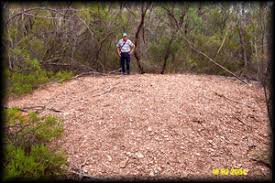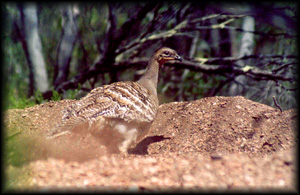 This photo was taken in the bush around Wedderburn. It is an extremely old Mallee Fowl nest which is believed not to have been used for around 500 to 600 years. If you look closely, you will note the circular shape of what was once a large mound of litter that the birds use for nesting. You can see that the track used by kangaroos and other wildlife emerges from the other side of the nest.
This photo was taken in the bush around Wedderburn. It is an extremely old Mallee Fowl nest which is believed not to have been used for around 500 to 600 years. If you look closely, you will note the circular shape of what was once a large mound of litter that the birds use for nesting. You can see that the track used by kangaroos and other wildlife emerges from the other side of the nest.
Further Information obtained about Mallee Fowl from the Mallee Fowl Preservation League. Our thanks to them for allowing us to include information in these pages. For more information on these unique birds, visit their site.
Other common names include:- malleehen; mallee fowl, incubator bird, native pheasant; bush chook and aboriginal names: gnow (naw, or ngow-o); lowan (low, or loan, Lawani); Nganamara
Mallee fowl (Leipoa ocellata) are large ground dwelling birds somewhat larger than a domestic hen. They belong to a family of 22 bird species known as “megapodes”(meaning big feet). Described as a ground dwelling bird, Malleefowl will take flight to roost in trees overnight and to escape immediate danger.
 Once common, their numbers have seriously declined over the last 100 years. Mallee fowl are classified as “fauna that is rare or likely to become extinct” under the Western Australian Wildlife Conservation Act 1950-91. Nationally, the Malleefowl is listed as vulnerable and is recognised as a species in need of national conservation efforts (National Recovery Plan for Malleefowl, Dr Joe Benshemesh 2000).
Once common, their numbers have seriously declined over the last 100 years. Mallee fowl are classified as “fauna that is rare or likely to become extinct” under the Western Australian Wildlife Conservation Act 1950-91. Nationally, the Malleefowl is listed as vulnerable and is recognised as a species in need of national conservation efforts (National Recovery Plan for Malleefowl, Dr Joe Benshemesh 2000).
Mallee fowl are unique to the arid and semi-arid regions of Australia. Megapode habitat is generally described as high rainfall tropical/subtropical (east and north coasts of Australia, New Guinea, Philippines, Indonesia and Western Pacific/Southern Indian Islands) however the Malleefowl differs from other megapodes having adapted to Southern Australian conditions.
The Malleefowl Mound
Mallee fowl dedicate 9-11 months per year building and maintaining a large incubation mound of soil, leaves and twigs. The eggs are laid in the mound, buried and left to incubate by heat generated from the composting litter. Malleefowl mounds may be used over many generations and can attain an impressive size of 22 metres in circumference and one metre high. Breeding densities vary. Surveys in South Western Australia indicate an average population of 2 active mounds per square km in 400 mm rainfall mallee habitat areas (Ongerup).
The Mallee fowl has developed a highly sophisticated method of temperature control for egg incubation. The birds maintain the mound temperature of 32-34 degrees by using their beak as a “thermometer” and adjusting soil cover to either retain or expel heat from the egg chamber. Towards the end of the breeding season (Feb./Mar) when heat generated from litter fermentation has diminished, solar energy is harvested by spreading and returning mound soil heated by the sun.
 For more information on Wedderburn, visit the friendly staff and volunteers at the Loddon Visitor Information Centre, located in what was the original Wedderburn Primary School now the Community Centre at 24 Wilson Street, Wedderburn
For more information on Wedderburn, visit the friendly staff and volunteers at the Loddon Visitor Information Centre, located in what was the original Wedderburn Primary School now the Community Centre at 24 Wilson Street, Wedderburn 